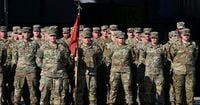In a significant diplomatic and military maneuver, the United States has begun deploying up to 200 troops to Israel to oversee the implementation of a newly brokered ceasefire with Hamas in Gaza, U.S. officials confirmed this week. The move follows the approval of a historic deal that aims to halt a devastating two-year conflict, and it marks a rare instance of direct American military involvement in facilitating Middle East peace efforts—albeit with boots firmly remaining outside Gaza itself.
The plan, announced on October 10, 2025, comes on the heels of marathon negotiations led by President Donald Trump. The agreement, reached after high-level meetings involving Israeli Prime Minister Benjamin Netanyahu, U.S. Special Envoy Steve Witkoff, and presidential adviser Jared Kushner, sets out a two-phase process: first, a ceasefire and the release of hostages, and later, a broader framework for peace and reconstruction in Gaza. According to i24NEWS, the U.S. troops are joining a multinational Civil-Military Coordination Center in Israel, alongside personnel from Egypt, Qatar, Turkey, and the United Arab Emirates.
American officials, eager to clarify the mission’s scope, have repeatedly stressed that no U.S. troops will enter Gaza. Instead, the deployment is designed to facilitate logistics, security, engineering, and humanitarian support from within Israel. “They will not be in Gaza. No U.S. boots on the ground in Gaza,” one official told NBC News. The troops, drawn from U.S. Central Command (CENTCOM), have been hand-picked for their expertise in military planning and logistics, and some were already stationed in the Middle East before the announcement. Others are arriving from across the globe, with their numbers expected to swell over the coming days.
The core of the operation is the establishment of the Civil-Military Coordination Center—a hub where military and political officials, as well as aid experts, can work together to ensure the ceasefire’s terms are met and humanitarian assistance flows smoothly into Gaza. “There will be a lot of players now in the Gaza Strip, and they will have to coordinate between them—and that is exactly what the center will do,” a senior U.S. official explained to i24NEWS. The center will also include representatives from non-governmental organizations and private-sector entities, reflecting the multifaceted nature of the reconstruction and aid effort.
The ceasefire agreement itself is ambitious. In its first phase, Israeli troops will withdraw to a designated “yellow line,” ceding some territory in Gaza but still maintaining control over more than half the enclave. Within 72 hours, Hamas is to release all remaining living and deceased hostages, while Israel will free hundreds of Palestinian prisoners. The United Nations, which has stockpiled 170,000 metric tons of aid for Gaza, is poised to send in hundreds of humanitarian aid trucks, pending Israeli approval. However, the UN and its primary agency for Palestinian aid, UNRWA, have faced months of restricted access—Israel had previously replaced most humanitarian operations in Gaza with the U.S.-backed Gaza Humanitarian Foundation, a move that has drawn sharp criticism from international observers.
The stakes could hardly be higher. The two-year conflict, which erupted on October 7, 2023, after Hamas attacked Israel—killing 1,200 people and taking about 250 hostages—has left Gaza in ruins. According to the Palestinian Health Ministry, more than 67,000 Palestinians, including thousands of children, have died, and millions have been displaced. The humanitarian situation has been described as catastrophic, with widespread starvation and a near-total collapse of infrastructure. Global organizations have sounded the alarm, and the United Nations has gone so far as to accuse Israel of committing genocide—an allegation Israeli officials have vehemently denied.
While the ceasefire has been broadly welcomed on the world stage, its fragility is apparent. The U.S. troops’ main task is to provide oversight and technical support, not to enforce the peace directly. Press Secretary Karoline Leavitt addressed confusion over the deployment, clarifying on social media that while some American troops are already in the region, others are arriving specifically to assist with the coordination center. The exact location of the center within Israel remains undecided, with officials working to finalize details as troops continue to arrive.
The agreement’s backers are keenly aware of the challenges ahead. “Most people in Israel either have children or neighbors or friends who are fighting in the war, and I think there’s a real relief to see this done. But with that being said, there’s real fear there about what will happen next. You know, will Gaza come up again to pose a threat?” a senior U.S. official told i24NEWS. The hope is that, by establishing a robust mechanism for coordination and verification, the parties can avoid the collapse of previous ceasefire attempts and move toward a more stable and prosperous future.
Arab states have pledged significant resources to support the demilitarization of Hamas and the restoration of governance in Gaza. The deal envisions the eventual establishment of a local police force, the dismantling of terror infrastructure, and the creation of conditions for economic recovery. “You can’t have a functioning place where people live if you have terrorists and militias running the place and you don’t have good rule of law and good governance,” a U.S. official noted. The ultimate goal, as articulated by both American and Arab negotiators, is to give Gaza’s residents a chance at a better life—something that has eluded them for decades.
Yet, skepticism lingers. Analysts have pointed out that Israel has previously failed to honor ceasefire agreements, and President Trump’s assurances to Hamas that the U.S. would enforce the deal are viewed with caution. The phased approach—hostage release, followed by broader demilitarization and reconstruction—reflects a “trust-but-verify” mentality, with each step contingent on progress in the previous one. The 20-point peace plan, which synthesizes lessons from past negotiations, was presented to Muslim and Arab leaders during the 2025 UN General Assembly and received positive feedback, according to U.S. officials.
For now, the world watches as American troops join their regional counterparts in Israel, working feverishly to make the ceasefire stick and bring much-needed relief to Gaza. The coming weeks will test the resolve of all parties—and the viability of a plan that aspires to turn the page on one of the Middle East’s most intractable conflicts.
As the dust settles, the true measure of this historic intervention will be whether it can deliver not just a pause in fighting, but a foundation for lasting peace and recovery in a land scarred by war.






